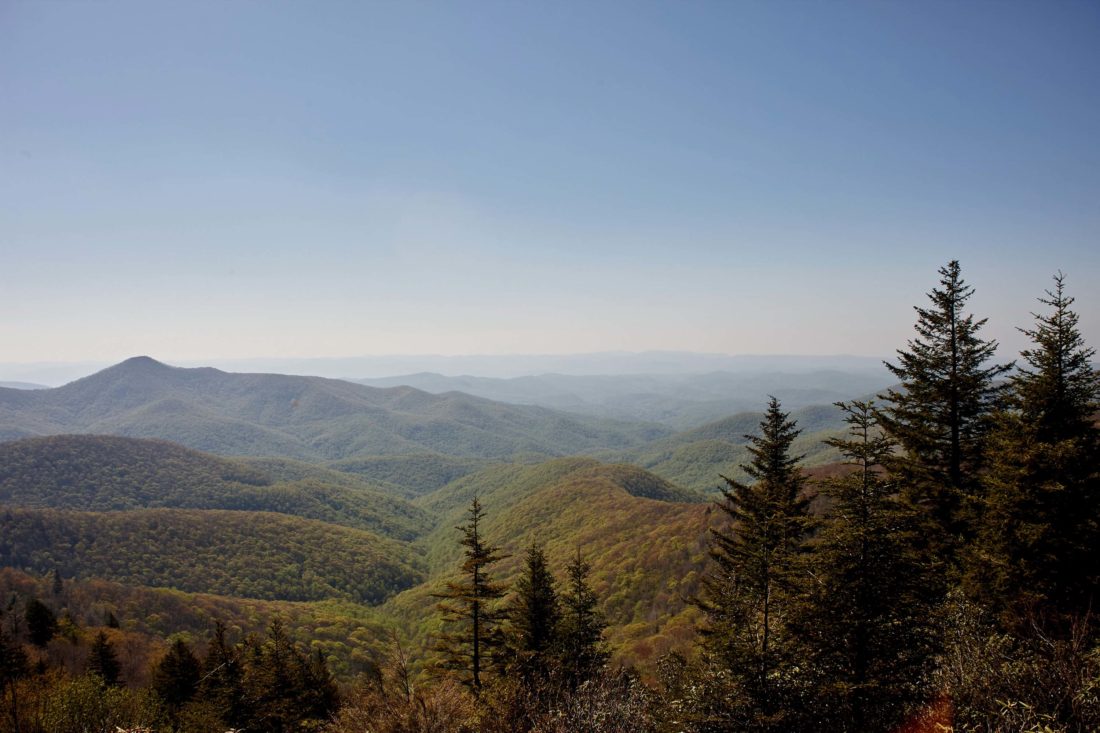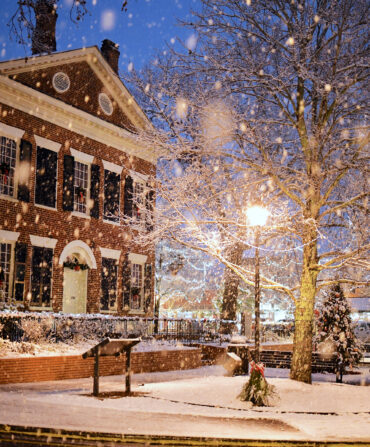A few miles west of Blowing Rock, North Carolina, near milepost 297 on the Blue Ridge Parkway, is Price Lake. In 1972, my cousin Mike and I fished here. He was just back from Vietnam. We fished until dark, little disappointed at our having no luck. His being home safe was all the luck we needed. Drive north a few miles and you’ll cross over a stone bridge built by the WPA during the 1930s. The stream that passes underneath is Middlefork Creek, where once I caught a rainbow trout big enough to warrant a paragraph in the Watauga Democrat. Another half mile down on the right is a road that leads to where my aunt Lee and uncle Roy lived. Besides their growing the best corn I’ve ever eaten, Aunt Lee tended an immense flower garden. One of my earliest memories is of watching butterflies brighten the mountain air above it.
Farther along, you’ll come to a pull-off on the right for Thunder Hill Overlook. In daylight the view is marvelous, a blue expanse that appears as endless as the sea. If you come at night to this area, you might look out and see the Brown Mountain Lights. Scientists have theorized that their source is fox fire or automobiles. However, local lore holds that the roving lights are lanterns carried by restless spirits. In their adolescence, my uncles and aunts came here with their dates, but I suspect their focus was not on otherworldly matters.
In another mile, if you look closely on the right, you might glimpse some graying locust posts linked by sagging strands of rusty barbed wire. My grandfather built that fence in the 1930s when he decided to raise cattle. In that pasture is a hill atop which, sixty years ago, you might have seen my cousins and me. We would be looking in your direction, playing a game where we guessed the next car tag’s color. Sometimes we’d venture closer to the parkway to identify the states: yellow could be Maine or Michigan, white Idaho or Kentucky, and the rarest color of all, the bright red of New Mexico. How strange it was as a child to know that people from so many places passed so close to our lives.
The parkway curves again, and as it straightens you will see an intersection at which there will be a sign that reads, Aho Gap Elev. 3722 ft. On the right is a meadow that was once a hayfield. When I was in high school, several afternoons I rode on the back of a battered Ford pickup, stacking hay bales my uncles tossed up to me. Next to the meadow is a small white house that belonged to my great-aunt Nell and great-uncle Col. If you turn right and follow this road, you’ll pass a brick house where my cousin Mike now lives. A few more miles and you will enter Dismal Gorge, a shadowy place where my uncles sometimes took me hunting and fishing. Once my uncle Earl and I came upon a rusting whiskey still, perhaps built and tended by one of our relatives, since plenty of kinfolk lived nearby.
On the left side of the parkway is another road. This turnoff was once the site of a general store. On an afternoon in the late 1800s, a group of men gathered here to decide what to call this community. No consensus came until one of the men stretched his arms and yawned: Ah ho. The community had its name. The store closed during the Depression, but my mother remembers lifting an orange soda from the icy slush of the metal box.
You may choose to go farther on the parkway toward Boone, but I will follow this road, which in memory is made of dirt. There is a pasture on the right, on the left a one-story clapboard farmhouse my grandfather built in the 1920s. My aunt Anna Belle lives there now, but I am remembering a summer evening when I was seven years old. I am on the front steps, my grandmother and my parents sitting on the porch. It is past my bedtime, but the thickening night hides me. The voices on the porch have a soft intimacy that makes the dark feel sheltering.
Even at this altitude, there are surrounding hills to block a view, but at night they seem to recede. Stars appear and the sky widens, gains depth. I am getting sleepy. Tomorrow morning I will awake early to the smell of eggs and bacon, for my uncle Earl is taking me fishing. We may go to Price Lake or take a left at the intersection and fish the stream that follows the parkway toward Boone. My cousin Mike will join us. In the afternoon, we’ll visit relatives, perhaps cross the parkway to visit Aunt Nell and Uncle Col. My cousins Jeff and Janet will come for supper, and later we’ll climb the pasture hill and watch the cars pass. But that is tomorrow.
More stars appear. Soon crickets trill in the pasture. The grass dampens with dew. If I leave the steps and go to sleep, tomorrow and its promises will come sooner. Instead, I wish only to linger on these porch steps, listening to the night, listening to those voices.








